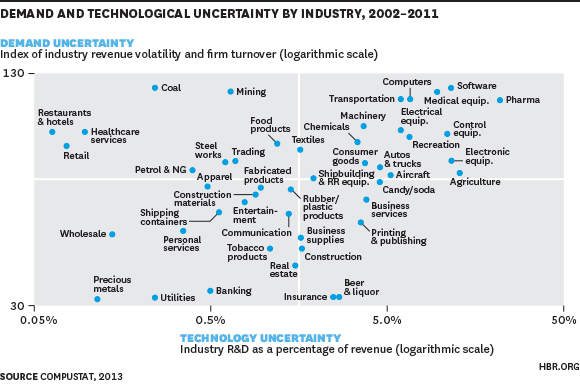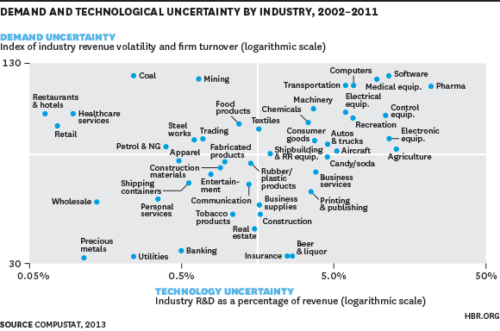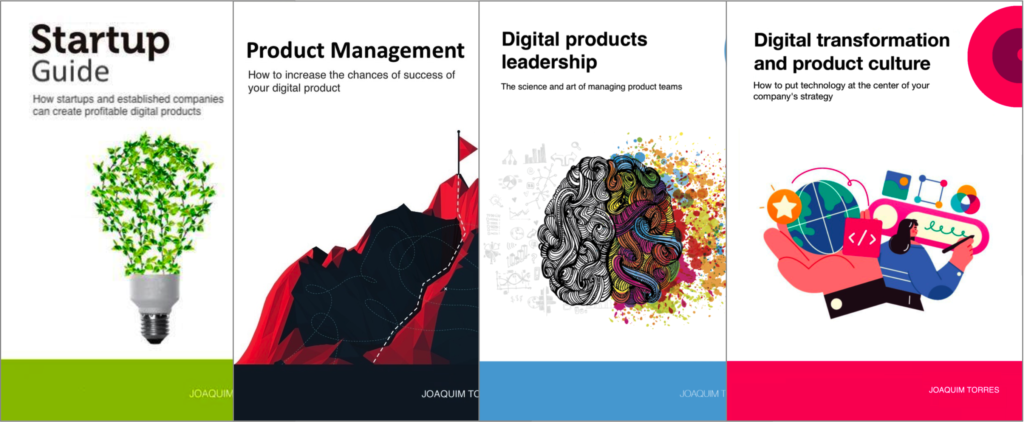
Project and product
14 de February, 2024
Types of company
26 de February, 2024This article is another excerpt from my newest book “Digital transformation and product culture: How to put technology at the center of your company’s strategy“, which I will also make available here on the blog. So far, I have already published here:
- About the book
- Part 1: Concepts
- Chapter 1: The so-called digital transformation – Project and Product
Let’s now dive into chapter 2, about:
Uncertainty and digital transformation
One aspect of digital transformations that seems to be common sense among the people responsible for helping companies go through this process is that the most difficult thing is not the digital and technological changes, but the cultural and mindset changes necessary for a successful transformation.
In this chapter, I will delve a little deeper into these necessary cultural and mindset changes, in the hope that we can better understand and address the obstacles that hinder the journey through digital transformations.
The impact of uncertainty on different industries
An interesting article in HBR on “Industries Plagued by the Great- est Uncertainty” (DYER; FURR; LEFRANDT, 2014) presents a chart in which many industries are shown according to:
- Technological uncertainty: can we build the desired solution? This uncertainty was measured as a weighting of investments in research and development (R&D) as a percentage of revenue;
- Demand uncertainty: will customers buy the product? This uncertainty was measured as a weight between the sector’s revenue volatility over the past 10 years and the percentage of companies in the sector that entered or exited during the same period.
Uncertainty of demand and technology by industry
As we can see, in the upper right region of the graph, we can find the computer and software industries alongside the pharmaceutical, medical equipment, and transport industries. These are the industries in which we have to invest the most in R&D and demand is the most uncertain. Computers and software are the newest; pharmaceutical, medical equipment, and transportation are more traditional, with technology and demand uncertainties similar to the computer and software industries.
When we analyze other more traditional sectors, such as banking, insurance, retail, entertainment, real estate, and construction, to name a few examples, they present less technological and demand uncertainty.
Digital transformation is more about transformation than digital
When a traditional company decides to embark on the journey of digital transformation, one thing that needs to be clear is that this journey has more to do with transformation than with digital. The digital aspect is very important, as technology is central to any digital transformation. However, it is relatively easy to find knowledge and experts who can help understand and address the technological aspects of a digital transformation. On the other hand, the transformation aspect of any digital transformation requires business and cultural changes that are considerably more difficult to implement. To make things even more difficult, there is not much knowledge available on this subject, so we tend to attribute its difficulty to a cultural issue and a somewhat generic mentality, which is correct, but insufficient to help us deal with the subject.
The demand and technology uncertainty chart can help us understand why business and cultural changes in a digital transformation can be so difficult. Traditional companies are typically accustomed to a certain level of technological and demand uncertainty. How- ever, when entering the digital world, the level of demand uncertainty (will the customer want it?) and technological uncertainty (will we be able to do it?) increases considerably.
In the computer and software industry, demand uncertainty is very high, one of the highest of all industries, which means that the software produced does not always meet its objectives. This success rate has improved in recent years with the evolution of techniques and principles for developing and managing digital products, but there are still many digital products that completely or partially fail to achieve the expected results. This can be very frustrating for a company in an industry with less demand uncertainty. To minimize demand uncertainty, we must make fast and frequent deliveries, which is a behavior that people in more traditional industries need to understand and adapt to deal with demand uncertainty for digital products.
On the other hand, technological uncertainty will require traditional companies to understand that (1) they will have to invest heavily and (2) investment in digital products is a multi-year investment. To illustrate this need for investment and its multi-year aspect, I will use two examples:
-
The first example is Amazon. It was founded in June 1994 and began operating in July 1995. It had an $8 million Series A investment round in June 1996. The IPO was in May 1997 and then Amazon received US $100 million in a post-IPO equity investment in July 2001 and only showed a profit in the 2001 Q4 earnings report. From founding to profit, it took 7.5 years and an investment of $108 million, plus money raised from angel investors and in the IPO.
- The second example is Nubank, a Brazilian digital bank founded in May 2013 that began operating in 2014. It raised US$ 1.87 billion from Series A to Series G. The IPO was in December 2021 and Nubank received US$1 billion in a post- IPO investment in February 2022. Its first positive result came in the 3rd quarter 2022 earnings report. Thus, from foundation to profit, it took almost 10 years and US$ 2.87 billion, plus money raised from angel investors and in its IPO.
It is important to note that Amazon is in the retail sector with low technological uncertainty and average demand uncertainty, and Nubank is in the banking sector with low technological and demand uncertainty, based on the graph of demand and technology uncertainty by sector presented previously. Both defined digital as a central part of their strategy to enhance results, and both understood that a lot of investment and many years would be needed to obtain positive results.
The further away an industry is from the software industry on the graph, the greater the transformation effort required. The company needs to understand that (1) digital product development requires a lot of investment and has many uncertainties, and (2) digital products need time to show a return on investment, probably multiple years.
People have different previous experiences
In the same way that companies in a given industry will require an effort proportional to the distance that this industry is from the software industry in the graph presented, the same happens with people who change a company in an industry in a scenario of less uncertainty and go for a company that has digital as a central part of its strategy.
An example to illustrate this point is the founders of Gympass: Cesar Carvalho was head of Business Development at CVC, a travel and tourism company and, before, he was a consultant at McKinsey; João Barbosa was Business Performance coordinator at CVC and previously worked in banks (Santander, Safra, and Citi); and Vinicius Ferriani was a project manager at Shiseido and was also a consultant at McKinsey. The three co-founders of Gympass had no experience in digitally mature companies when they decided to create Gympass and they had to develop this maturity over the years by talking to people who had this maturity and bringing people with this maturity to the team.
Another example is Nubank. While David Vélez had worked at two investment funds closely linked to the digital world (Sequoia Capital and General Atlantic) before founding Nubank and Edward Wible had a degree in Computer Science from Princeton and worked with digital companies both in a consultancy (BCG) as well as for an investment company (Francisco Partners), Cristina Junqueira only had experience in more traditional companies such as banks (Itaú, Unibanco, LuizaCred) and consultancies (BCG, Booz Allen Hamilton). Cristina Junqueira’s adaptation to more digital culture was likely more intense than David Vélez and Edward Wible’s adaptation.
Recommendation
Digital transformation is a path with many uncertainties and requires investment for several years until this investment pays off.
This aspect of digital transformations makes people who have experience in more stable industries very uncomfortable and, consequently, very anxious, expecting results as early as next month or, at most, the next semester.
This discomfort and anxiety, especially in senior leadership, in the C-level, and on the company’s Board, can be a major obstacle to the success of digital initiatives. For this reason, it is important to have this understanding of the uncertainty, the need for investment, and the long-term – multi-year – nature of this investment, so that people have the necessary patience to reap the eagerly awaited results.
On the other hand, investing in digital transformation cannot be done with your eyes closed. It must be constantly monitored. From the beginning of the investment, it is possible to have indicators and even partial results that, although far from covering the investments, already show whether it is going in the right direction.
Summing up
- The digital aspect of digital transformation is relatively easy, as there is a lot of knowledge and many experts to help design, develop, and implement digital products. Digital product management and development techniques have evolved at a rapid pace.
- The transformation aspect of a digital transformation is more difficult, as there is not much knowledge about it and we tend to attribute its difficulty to a cultural and mentality issue, which is somewhat generic.
- Demand and technological uncertainties in the software industry are what hinder digital transformation. Traditional companies that are in less unstable contexts have difficulty understanding and, consequently, dealing with these uncertainties.
- Being able to understand the background context of people who are working on a digital transformation can help deal with the struggles and problems we may face in a digital transformation, especially with its transformation aspect.
Workshops, coaching, and advisory services
I’ve been helping companies and their leaders (CPOs, heads of product, CTOs, CEOs, tech founders, and heads of digital transformation) bridge the gap between business and technology through workshops, coaching, and advisory services on product management and digital transformation.
Digital Product Management Books
Do you work with digital products? Do you want to know more about managing a digital product to increase its chances of success, solve its user’s problems, and achieve the company objectives? Check out my Digital Product Management books, where I share what I learned during my 30+ years of experience in creating and managing digital products:
- Digital transformation and product culture: How to put technology at the center of your company’s strategy
- Leading Product Development: The art and science of managing product teams
- Product Management: How to increase the chances of success of your digital product
- Startup Guide: How startups and established companies can create profitable digital products



